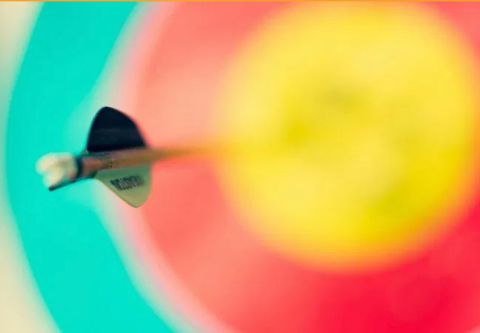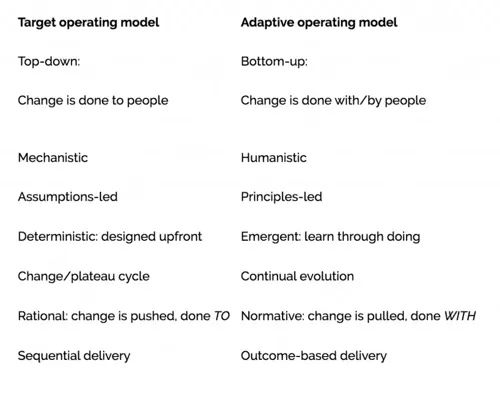We need to talk about Target Operating Models…

…because the dream never quite lives up to reality. I see it every day in my role. Organisations that planned the perfect Target Operating Model (TOM) with everything ordered and colour-coded, only the reality is a chaotic mess because organisations are complex, rapidly changing beasts.
Take a moment to think about how the pandemic has impacted your business:
- Was it easy to enable remote working?
- Has your culture survived through a screen?
- Did you thrive or merely survive?
- And in what ways did your operating model help/hinder your success?
It’s perhaps the biggest issue we need to consider when we embark on a change initiative: Is everything broken?
Yes, you could probably simplify areas, speed up and approach change with a continual improvement mindset. But in reality, most operational parts of the organisation work OK. The problem lies in how change is delivered – which means primarily the delivery operating model is broken.
A dependence on traditional ways of working, determinism, functional structures and the division of labour has compounded the problem as the pace of change has accelerated. The result is:
- Slow time-to-value
- Overruns in time and cost
- Siloed working with lots of handoffs
- A focus on output and activity, rather than outcomes
- A lack of customer-centricity
We regularly see the effects of a classic TOM initiative: a big consultancy is brought in. The focus is on ‘As-Is’ navel-gazing, with months of design and definition. This ends up as a beautifully designed solution, which is articulated through hundreds of pages of PowerPoint and process flows. But the ‘As-Is’ is never as useful as you think – and often, it constrains the outcome. The design is often assumption-led and therefore lacks real context, thus becoming a desktop exercise. And then we get to the tough bit: implementation.
What you get is:
- Lack of ownership
- Failure of the changes to stick long-term
- A ‘not invented here’ syndrome
- Leaders who are unable to give the change the attention it needs
- People feel change is done to them
Failed change is inevitable because, in reality, this up-front design, top-down approach simply doesn’t work. We assume that ‘if we think it, we will do it’ – that new knowledge drives behaviour. On rare occasions it might, but only when the idea is aligned to the original mindset, and the required action is easy. Ask anyone who has tried to take more exercise, eat more healthily or give up smoking. They have the knowledge about why that is a good idea, but many struggle to create new behaviours and habits.
This is sometimes called a ‘rational approach’ to change and is endemic in organisations: ‘I’ll talk, you listen’. So what’s the alternative?
Let’s flip to a different approach…
Instead, let’s consider ‘emergent design’, which uses empowered people who assume ‘if we do it, we will start to think it’. This is known as a ‘normative approach’ to change: ‘I’m not here to tell you anything, but we will study the ‘system’ in front of us together’. When we do, we will DISCOVER dysfunction, delays and idiosyncrasies that were never intended. It fits better with how humans learn best, because when we discover for ourselves, we become more open to change and actively search for new ideas and solutions.
This is the principle behind the S&S adaptive operating model. People are informed of WHAT needs to happen and WHY, but are empowered to figure out the HOW for themselves.
What makes an Adaptive Operating Model Different?
The following table is designed to show at-a-glance the differences between a traditional TOM and an adaptive operating model – and why the latter is more conducive to sustainable change:

At S&S we implement adaptive operating models using the Glass Tube approach. A rapid immersion into modern delivery techniques, we pull together an empowered, cross-functional, exemplar client team. The client team is paired with a few S&S change experts and they all swarm on a complex problem and solve it, while making it highly transparent to the rest of the organisation. It starts with a look inside the Glass Tube…
The team is set a mission rather than given an intended solution with some requirements (a project scope). The magic of a mission is that it doesn’t pre-suppose the solution. It instead encourages ownership and innovation. Instead of ‘build me a new payments system’ we would task the team with a mission such as ‘we want our customers to be able to pay anytime, anyhow, anywhere using a frictionless experience that is low cost for the organisation’. One of their ideas may be a new payments system. Often they come up with UX, process or automation options that can deliver value much faster.
In the Glass Tube, the team learns through doing, not training. New ways of working emerge, relevant for their context and created by the team itself. Outsiders can clearly see what’s happening but the ‘tube’ prevents them from interfering and slowing the pace of change. As an outsider looking in, they can see the full complexity of the task at hand. They can see how the team is evolving and organising to solve the mission, by validating assumptions in real-time and releasing value regularly.
A Glass Tube approach leads to a groundswell of excitement, a ‘bow wave’ of empowered, engaged and motivated employees who scale their energy and new skills across the organisation via peer-to-peer influence. It works because change is created from the inside out and uses existing employees to scale the energy.
And that’s going to benefit your business because it leads to a dramatic improvement in time-to-value. It’s going to benefit your employees because they’re more engaged, which leads to lower attrition and creates a breeding ground for business leaders of the future. And it’s going to benefit your customers, because you become customer-obsessed, focused on meeting their needs and delivering a better experience.
For more information on implementing an adaptive operating model and the Glass Tube approach, contact us today.

Adrian Stalham
Chief Change Officer